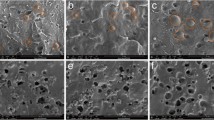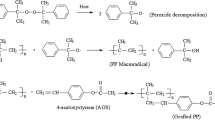Abstract
Polypropylene (PP) receives significant interests because of environmental friendship and excellent insulation. The development of PP cables depends heavily on the semi-conductive shielding layers that match the PP insulation layers. In this paper, propylene–ethylene copolymer (POP) is used to toughen the PP-based shielding layer. The effects of POP content (40 parts, 50 parts and 60 parts) on the electrical and mechanical characteristics are investigated. Further, the interface matching characteristics and toughening mechanism of the shielding layer are explored. According to the experimental findings, owing to the growth in POP content, the distribution of carbon black (CB) particles becomes more uniform, and the surface roughness decreases from 52.7 nm to 14.7 nm. When the POP content is 60 parts, the charge injected into the insulation layer is the least, which is 0.643 × 10−7 C, and the maximum electric field distortion decreases to 11.4 kV/mm. All three POP content shielding layers maintain a low resistivity at high temperatures (110 ℃, 80 Ω·cm). Besides, as the POP content increases, the toughness of PP-based shielding layer is improved and the elongation at break of POP-60 semi-conductive shielding layer reaches 420%. This research paves a new way for the development of semi-conductive shielding layer of PP cables.










Similar content being viewed by others
References
Teyssedre G, Laurent C (2013) Advances in high-field insulating polymeric materials over the past 50 years. IEEE Electr Insul Mag 29(5):26–36
Luo Y, Luo JW, Li B (2018) Performance of cross-linked polyethylene insulated cable based on detection of high voltage electric field. Trans Electr Electron Mater 20:40–45
Gao CF, He DX, Zhou YF, Wang W, Wang P (2019) A study on the space charge characteristics of AC sliced XLPE cables. IEEE Access 7:20531–20537
Bawareth M, Xu WH, Ravichandran D, Zhu YX, Jambhulkar S, Fonseca N, Miquelard-Garnier G, Camille V, Matthew L, Campbell W, Song K (2022) Crosslinked polyethylene (XLPE), recycling via foams. Polymers 14(13):2589
Ahmad H, Rodrigue D (2022) Crosslinked polyethylene: a review on the crosslinking techniques, manufacturing methods, applications, and recycling. Polym Eng Sci 62(8):2376–2401
Fu M, Chen G, Dissado L, Fothergill J (2007) Influence of thermal treatment and residues on space charge accumulation in XLPE for DC power cable application. IEEE Trans Dielectr Electr Insul 14(1):53–64
Hosier IL, Vaughan AS, Swingler SG (2011) An investigation of the potential of polypropylene and its blends for use in recyclable high voltage cable insulation systems. J Mater Sci 46(11):4058–4070
Huang XY, Fan YY, Zhang J, Jiang PK (2017) Polypropylene based thermoplastic polymers for potential recyclable HVDC cable insulation applications. IEEE Trans Dielectr Electr Insul 24(3):1446–1456
Ouyang BH, Huang KW, Zhao P, Liu SH, Zhao JK, Liu SW (2022) Research progress of polypropylene materials for power cables. Insul Mater 55(08):6–15 ((in Chinese))
Yu S, Lee SH, Han JA, Park H, Han SW, Lee DH (2020) Insulative ethylene-propylene copolymer-nanostructured polypropylene for high-voltage cable insulation applications. Polymer 202:122674
Yang JM, Gao MZ, Zhao H, Liu SL, Hu M, Xie SH (2019) Space charge characteristics of polypropylene modified by rare earth nucleating agent for β crystallization. Materials 12(1):42
Ramírez-Vargas E, Navarro-Rodríguez D, Huerta-Martínez BM, Medellín-rodríguez FJ, Lin JS (2000) Morphological and mechanical properties of polypropylene [PP]/poly(ethylene vinyl acetate) [EVA] blends. I. Homopolymer PP/EVA systems. Polym Eng Sci 40(10):2241–2250
Ramírez-Vargas E, Medellín-Rodríguez FJ, Navarro-Rodríguez D, Avila-Orta CA, Solís-Rosales SG, Lin JS (2002) Morphological and mechanical properties of polypropylene [PP]/poly(ethylene vinyl acetate) [EVA] blends. II: Polypropylene~(ethylene~propylene) heterophasic copolymer [PP~EP]/EVA systems. Polym Eng Sci 42(6):1350–1358
Green C, Vaughan A, Stevens G, Pye A, Sutton S, Geussens T, Fairhurst M (2015) Thermoplastic cable insulation comprising a blend of isotactic polypropylene and a propylene-ethylene copolymer. IEEE Trans Dielectr Electr Insul 22(2):639–648
Wei YH, Han W, Li GC, Lei QQ, Fu ML, Hao CC, Zhang GJ (2020) Research progress of semi-conductive shielding layer of HVDC cable. High Voltage 5(1):2397–7264
Li ZL, Zhao YT, Han T, Du BX (2021) Research progress and prospect of semi-conductive shielding composites for high-voltage cables. Trans China Electrotech Soc 37(09):2341–2354 ((in Chinese))
Zhu W, Dong F, Hou BP, Gwatidzo WKT, Zhou L, Li G (2020) Segmenting the semi-conductive shielding layer of cable slice images using the convolutional neural network. Polymers 12(9):2058
Fasihi M, Mansouri H (2016) Effect of rubber interparticle distance distribution on toughening behavior of thermoplastic polyolefin elastomer toughened polypropylene. Appl Polym. https://doi.org/10.1002/app.44068
Sun BY, Chen Z, Xie A, Zhang J, Jiang KP, Huang XY (2020) Highly filled polypropylene/carbon black shielding materials for power cables. High Volt Eng 46(05):1625–1632 ((in Chinese))
Yang JM, Zhang R, Yang X, Sun Z, Zhao X, Zhao H, Wang X, Li L, Liu HQ (2022) Optimisation method for carbon black distribution of polypropylene-based semi-conductive screen materials and its effect on charge emission behaviour at screen/insulation interface. High Volt 8:239–250
Liu WF, Cheng L, Li ST (2018) Review of electrical properties for polypropylene based nanocomposite. Compos Commun 10(7):221–225
Wang JF, Liu ZM, Li YX, Wu J, Han PK, Zheng XQ (2011) Influence of chemical cross-linking on water treeing in polythene. High Volt Eng 37(10):2477–2484 ((in Chinese))
Yokoyama Y, Ricco T (1998) Toughening of polypropylene by different elastomeric systems. Polymer 39(16):3675–3681
Acknowledgements
This work was supported in part by the National Natural Science Foundation of China (Grant No. 52107154). Youth Innovation Technology Project of Higher School in Shandong Province (Grant No. 2021KJ023). State Grid Shandong Electric Power Company Science and Technology project (No. 52062621N003).
Funding
This work was supported in part by the National Natural Science Foundation of China (Grant No. 52107154). Youth Innovation Technology Project of Higher School in Shandong Province (Grant No. 2021KJ023). State Grid Shandong Electric Power Company Science and Technology project (No. 52062621N003).
Author information
Authors and Affiliations
Contributions
YW was involved in investigation, experiments, analysis. LL helped in data curation. TL contributed to IR experiment. XL was involved in investigation. YD helped in investigation. CH contributed to conceptualization, investigation, review. GL helped in conceptualization. Shengtao Li contributed to conceptualization.
Corresponding author
Ethics declarations
Conflict of interest
The authors hereby declare that they have no competing interests as defined by Springer or other interests that might be perceived to influence the results and/or discussion reported in this paper.
Additional information
Publisher's Note
Springer Nature remains neutral with regard to jurisdictional claims in published maps and institutional affiliations.
Rights and permissions
Springer Nature or its licensor (e.g. a society or other partner) holds exclusive rights to this article under a publishing agreement with the author(s) or other rightsholder(s); author self-archiving of the accepted manuscript version of this article is solely governed by the terms of such publishing agreement and applicable law.
About this article
Cite this article
Wei, Y., Liu, L., Liu, T. et al. Electrical and mechanical properties of POP-toughening semi-conductive shielding layer for PP cables. Electr Eng 106, 315–322 (2024). https://doi.org/10.1007/s00202-023-01986-1
Received:
Accepted:
Published:
Issue Date:
DOI: https://doi.org/10.1007/s00202-023-01986-1




